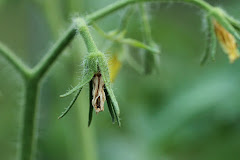
The best way to tell when fruit is ready to harvest is often the simple taste test. For backyard gardeners not concerned with shipping fruit, this is good advice for apples, peaches, plums and grapes.
Pears are the exception. “Tree ripened” pears will not be satisfactory. Pears left on trees ripen from the inside out and stone cells fully develop making for “gritty” eating. When the outside is ready, the inside is often brown mush. If picked slightly immature, they ripen uniformly with a smoother flesh consistency OFF the tree.
Harvest most European pears such as ’D'Anjou’ (photo above) and 'Bartlett' when they easily detach from trees. Tilt them upward to horizontal and they come loose when ready for harvest. ‘Bosc’ pears (photo right) are always difficult to separate from the tree and stems may have to be clipped with a sharp pruner. All pears should feel hard when picked.

In looking for signals for when to harvest, disregard the red blush on varieties that develop it such as D'Anjou (photo above). The ground color of the pear skin will change to more closely resemble the mature pear of that variety. With Bartlett, D’Anjou and other yellow pear varieties, skin becomes a lighter green.
Pears then have to be ripened indoors. Some pears such as D'Anjou require cold storage before ripening. Bartlett does not but 2 days of chilling may help even ripening. D’Anjou and Bosc should be chilled for 2 weeks in the refrigerator away from apples, onions, potatoes and other fruits and vegetables. Pears in grocery stores and those shipped by specialty mail order companies have already been given their chilling treatment.
Ripen at room temperature, 65 to 75 degrees F. Warm temperatures of 85 degrees F or higher interfere with ripening. Bartlett pears generally ripen in 5 days, Bosc in 7 days and D’Anjou in 7 to 10 days. The longer pears are chilled, the shorter the ripening time when removed from cold storage.
Pears naturally produce ethylene gas inside the fruit as they ripen. You can shorten ripening time by placing pears in a closed paper bag with a ripe banana or apple, both of which produce ethylene to speed ripening.
Pears are ready to eat when the flesh just below the stem yields evenly to gentle pressure.
Photo credit: d'Anjou pears, Bosc pears - both Carl Wilson
 As they say in real estate – location, location, location. This savvy gardener hedged his bets by cultivating plots in several community gardens that were unaffected. These low lying areas are bad bets for growing fruit trees.
As they say in real estate – location, location, location. This savvy gardener hedged his bets by cultivating plots in several community gardens that were unaffected. These low lying areas are bad bets for growing fruit trees.












